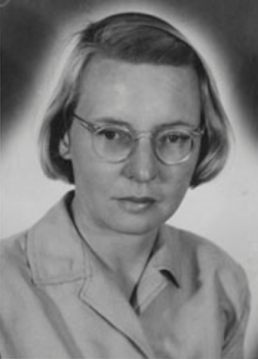These life stories may contain descriptions of childhood trauma and abuse, as well as images, voices and names of people now deceased. If you need help, you can find contact details for some relevant support services on our support page.
First woman radio astronomer, Ruby Payne-Scott (1912 – 1981), lived away from her family as a teenager.
Ruby Violet Payne-Scott was born in Grafton, a city in New South Wales about 608 km north of Sydney. Ruby’s parents, Amy and Cyril, also had a son, Henry, born a year after Ruby. By 1915, the family had moved and because of the lack of records, little is known about Ruby’s early education, although she and Henry may have been home-schooled since Amy was a teacher.
Between 1923 and 1925 Ruby attended the Cleveland Street School in Sydney. It appears that her parents and Henry did not move to Sydney until 1925, and therefore it is likely that Ruby was living with a maternal aunt, Eva Mary Neale.
Armed with her Intermediate Certificate, Ruby then attended Sydney Girls High School, completing her Leaving Certificate in 1928 and commencing at the University of Sydney the following year.
Ruby was the third woman to attain a degree in physics from the University of Sydney. She then gained a Masters of Science in 1936 with research undertaken at the Cancer Research Committee, also at the University of Sydney. Two years later, Ruby was awarded a Certificate of Education and for twelve months, worked at the Woodlands church of England Girls’ Grammar School in Adelaide, South Australia.
In August 1941, Ruby Payne-Scott began her ten year term as a scientist at the CSIR (Council for Scientific and Industrial Research, renamed the Commonwealth Scientific and Industrial Research Organisation (CSIRO) in 1949) Division of Radiophysics.
She was part of a pioneering group of radar scientists during the Second World War, led by J.L. Pawsey, whose scientific distinction and leadership qualities have been referred to by all writers in the field. Although it was mainly due to him that radio astronomy developed in Australia from 1944, she was one of the key people contributing to Australia’s pre-eminence in the world of radio astronomy for many decades (p. viii, Goss & McGee).
Her work led to the discovery of deep-space phenomena like black holes and pulsars and later helped astronauts understand how solar storms disrupt weather in space and electrical grids on Earth (Halleck).
Ruby Payne-Scott left the radio astronomy community shortly before the birth of her first child in 1951, perhaps disenchanted because of the controversy caused by her not revealing her marriage to William Hall. According to the law—not changed until 1966—women employees of the Australian Public Service had their permanent positions revoked upon marriage. After her marriage came to light, Payne-Scott lost what pension contributions her employer had made for that time and her permanent position was converted to a temporary one.
Ruby Hall cared for her children, Peter and Fiona, until they were about ten and twelve, and then taught maths and science at Danebank Anglican School for Girls from 1963 to 1974.
It was many years before Ruby Payne-Scott received public recognition for her contribution to radio astronomy. Then in 1999, Danebank School initiated the Ruby Payne-Scott Lecture (given by women scientists), in 2008 the CSIRO established the Ruby Payne-Scott Award, in 2017 the University of Sydney set up the Payne-Scott Professorial Distinctions, and in 2018, The New York Times published a much-belated obituary.
References:
Goss, William & McGee, Richard. Under the radar: the first woman in radio astronomy. Berlin, Springer-Verlag, 2009.
Goss, William. Making Waves. The Story of Ruby Payne-Scott: Australian Pioneer Radio Astronomer. Berlin: Springer-Verlag, 2013.
Halleck, Rebecca. “Overlooked No More: Ruby Payne Scott, Who Explored Space with Radio Waves.” The New York Times, 29 August 2018. Available here.
Image available here.
